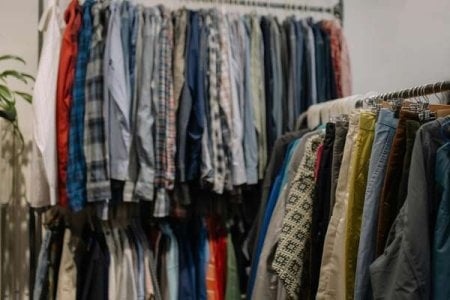Discover the $850 Thrift Shop Discovery that Unveils Australia's Heartbreaking New Trend – Are You Encouraging It Without Knowing?
By
Danielle F.
- Replies 7
In The Land Down Under, where the spirit of mateship and community has long been celebrated, a concerning trend is emerging in the most unexpected of places – our beloved thrift shops. These havens of secondhand treasures, once the go-to for bargain hunters and the budget-conscious, are now showcasing price tags that would make even the most seasoned shopper's eyes water.
Recently, a woman's discovery of an $850 secondhand Burberry jacket at a Brisbane charity shop has sparked outrage and highlighted a sad trend sweeping across Australia. The price, deemed 'ridiculous' by the finder, has reignited the debate over the affordability of items in op-shops and the role these stores play in our communities.
The thrift shop conundrum is not isolated to Brisbane. Sarah, from Cooma, NSW, echoed similar sentiments when she encountered exorbitant prices at her local Salvos store. Brand name clothing, children's jackets, and even basic shirts were marked up to a point where they were no longer accessible to those who traditionally relied on these stores for affordable necessities.
This shift in pricing strategy has not gone unnoticed by industry experts, who are calling for regulation in the sector. Dr Andrew Hughes from the Australian National University points out that charity stores, many of which are run by faith-based organizations, are straying from their mission to serve those in need. With tax exemptions and a move towards professional business operations, these stores are now accused of failing the very communities they were established to support.
The ethical dilemma is clear: while the items may be fairly priced in a market sense, the question remains whether it is ethically fair to charge such amounts in the context of charity operations and their intended customer base. The original purpose of thrift shops was to offer affordable goods to those struggling financially, but with current pricing, even middle-income earners are finding themselves priced out.
As a result, Australians are altering their spending habits, turning to ultra-cheap online retailers like Temu, despite the ethical and environmental concerns associated with such choices. This shift not only raises questions about the sustainability of our consumer practices but also drives business offshore, impacting the local economy.
The dominance of major charity stores like Vinnies and The Salvation Army in the market allows them to set prices without fear of competition, creating a near-perfect business model that capitalizes on donated goods. The concern is that this model is at odds with the charitable ethos that once defined these organizations.
So, what can we do as consumers? It's time to reflect on our role in this trend. Are we inadvertently encouraging these practices by accepting the high prices without question? Should we demand more accountability and transparency from our charity stores? Or perhaps, should we consider more direct ways of supporting those in need, bypassing the middleman altogether?
As members of the Seniors Discount Club, we have the power to influence change through our choices and voices. Let's start a conversation about the true cost of these 'bargains' and how we can return to the core values of community support and accessibility that thrift shops were built upon.

We invite you to share your thoughts and experiences. Have you come across similar pricing in your local thrift shops? How has this affected your shopping habits? Join the discussion below and let's tackle this issue together, for the sake of our communities and the true spirit of giving.
Recently, a woman's discovery of an $850 secondhand Burberry jacket at a Brisbane charity shop has sparked outrage and highlighted a sad trend sweeping across Australia. The price, deemed 'ridiculous' by the finder, has reignited the debate over the affordability of items in op-shops and the role these stores play in our communities.
The thrift shop conundrum is not isolated to Brisbane. Sarah, from Cooma, NSW, echoed similar sentiments when she encountered exorbitant prices at her local Salvos store. Brand name clothing, children's jackets, and even basic shirts were marked up to a point where they were no longer accessible to those who traditionally relied on these stores for affordable necessities.
This shift in pricing strategy has not gone unnoticed by industry experts, who are calling for regulation in the sector. Dr Andrew Hughes from the Australian National University points out that charity stores, many of which are run by faith-based organizations, are straying from their mission to serve those in need. With tax exemptions and a move towards professional business operations, these stores are now accused of failing the very communities they were established to support.
The ethical dilemma is clear: while the items may be fairly priced in a market sense, the question remains whether it is ethically fair to charge such amounts in the context of charity operations and their intended customer base. The original purpose of thrift shops was to offer affordable goods to those struggling financially, but with current pricing, even middle-income earners are finding themselves priced out.
As a result, Australians are altering their spending habits, turning to ultra-cheap online retailers like Temu, despite the ethical and environmental concerns associated with such choices. This shift not only raises questions about the sustainability of our consumer practices but also drives business offshore, impacting the local economy.
The dominance of major charity stores like Vinnies and The Salvation Army in the market allows them to set prices without fear of competition, creating a near-perfect business model that capitalizes on donated goods. The concern is that this model is at odds with the charitable ethos that once defined these organizations.
So, what can we do as consumers? It's time to reflect on our role in this trend. Are we inadvertently encouraging these practices by accepting the high prices without question? Should we demand more accountability and transparency from our charity stores? Or perhaps, should we consider more direct ways of supporting those in need, bypassing the middleman altogether?
As members of the Seniors Discount Club, we have the power to influence change through our choices and voices. Let's start a conversation about the true cost of these 'bargains' and how we can return to the core values of community support and accessibility that thrift shops were built upon.
Key Takeaways
- An Australian op-shopper expressed her shock over the high prices in charity shops after finding a secondhand Burberry jacket priced at $850.
- The steep pricing has triggered a conversation about the need for regulation in the sector, with experts criticising charity stores for failing their community's needs.
- Dr Andrew Hughes from the Australian National University highlighted that charity stores, often run by faith-based organisations, should have a responsibility to keep prices accessible, especially given their tax-exempt status.
- The article suggests that exorbitant prices in charity stores are forcing Australians to seek alternatives such as low-cost retailers or online options, potentially driving business away from local charity stores and raising ethical and environmental concerns.








